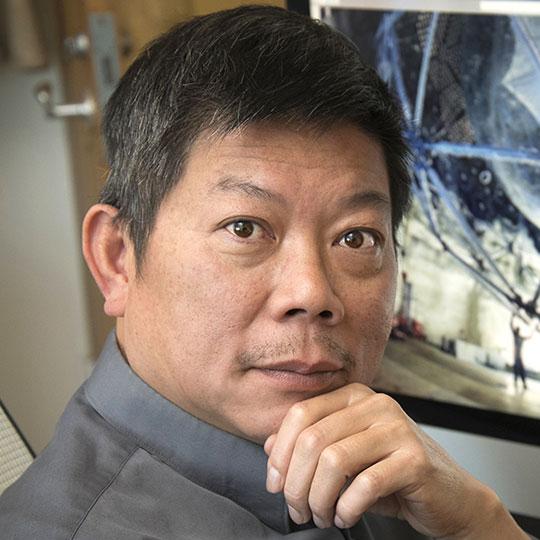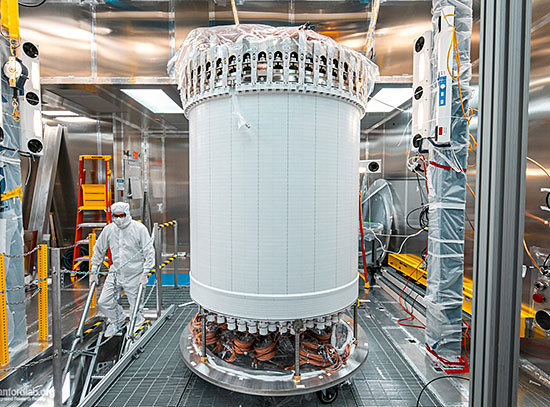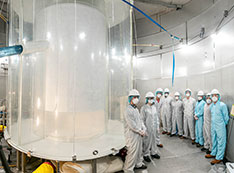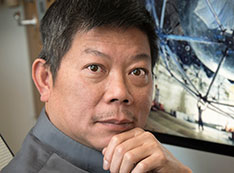- Home
-
Research Groups
Division Groups
- Artificial Photosynthesis
- Catalysis: Reactivity & Structure
- Electrochemical Energy Storage
- Electron- and Photo-Induced Processes for Molecular Energy Conversion
- Neutrino and Nuclear Chemistry
- Surface Electrochemistry and Electrocatalysis
Associated Groups
- Catalysis for Alternative Fuels Production
- Nanostructured Interfaces for Catalysis
- Structure and Dynamics of Applied Nanomaterials
- People
- Operations
- News
- Events

Neutrino and Nuclear Chemistry
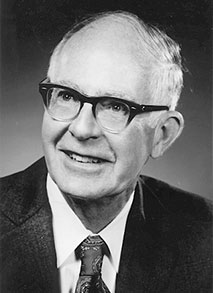
Raymond Davis Jr., member of BNL's Chemistry Division for more than 35 years and co-winner of the 2002 Nobel Prize in Physics for the detection of solar neutrinos.
Basic research on neutrinos has a long history in the Brookhaven Chemistry Division. The Neutrino and Nuclear Chemistry group initiated and operated the pioneering experiments that first uncovered the famous solar neutrino deficit using chemical detection of nuclear transformations induced by solar neutrinos using 615 tons of C2Cl4, and later participated in the GALLEX solar neutrino experiments in Gran Sasso, Italy where 30 tons of Gallium comprised the neutrino detector. The pioneering experiments conducted in the Homestake Mine, Lead, South Dakota, led to the awarding of the 2002 Nobel Prize in Physics to Raymond Davis, Jr., the founder of this group.
The NNC Group was a participant in the very successful solar neutrino experiment, the Sudbury Neutrino Observatory (SNO) in Sudbury, Ontario. The neutrino detection medium in SNO is 1000 tons of D2O, which is valued at approximately US$ 300 Million. The SNO "solved" the forty years old, solar-neutrino-problem by demonstrating that two-thirds of the electron neutrinos emitted by the Sun transformed into the two other flavors, tau and mu, neutrinos and won the 2015 Nobel Prize in Physics [jointly with Kamiokande experiment, for the discovery of neutrino oscillation. SNO was also awarded the 2016 Breakthrough Price in Fundamental Physics along with four other neutrino experiments.
Neutrino research has since marched into an era of precision measurement regarding neutrino oscillations, neutrino flavors, and neutrino mass. The group continues to develop varied detector target materials to continuing study of these neutrino properties, and to expanding our proficiency into other scientific fields including nonproliferation, dark matter, and medical physics. To date NNC has world-leading experts in scintillator detector from bench-top development to in-house ton-scale facility for purification, and production of metal-doped and water-based liquid scintillator. NNC is also a current member of several international collaborations:
- LZ (LUX and ZEPLIN) dark matter search at SURF, SD (2013-present),
- SNO+ neutrinoless double-beta decay search at SNOLAB, Canada (2004-present)
- PROSPECT Short-baseline Reactor Antineutrino at ORNL, TN (2013-present),
- Daya Bay reactor antineutrino experiment a 1% precision of theta-13 measurement at Daya Bay, China (2004-present),
- AIT/NE0 (WATCHMAN) long-range nuclear reactor monitoring for nonproliferation, planned at Boulby Underground Laboratory, UK (2016-present) and
- THEIA, a multiple physics program using large scintillation Cerenkov detector (location to be defined, 2017-present).




